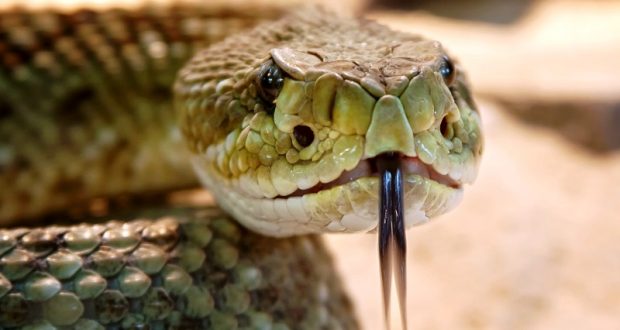Article by Leonard Andrenacci.
Summer is rattlesnake season, so try to be aware and extra careful when enjoying the great outdoors. Most of us hike trails, cut firewood, work, and live in the mountains and will eventually run into a snake, and sometimes it will be a rattlesnake. Rattlesnakes, for the most part, are timid creatures and try to stay concealed, blending in with the landscape while quietly waiting for prey.
There are two types of rattlesnakes in the mountains: the western diamondback and the timber rattlesnake. The timber rattlesnake is, for the most part, a higher elevation version of the western rattlesnake. The geographic range of the western diamondback includes Mexico, New Mexico, Arizona, and California. It can be found at sea level and up to 9,000 feet.
Most encounters with rattlesnakes are accidental, often while hiking or collecting firewood. Younger, smaller rattlesnakes are often hard to see and can be more aggressive simply because when snakes are young they are usually prey to other animals, so they tend to bite and snap at almost anything, while adult rattlesnakes are generally calmer and strike less often (unless provoked or cornered.) Rattlesnakes can and will, however, become overly aggressive and territorial if their den is threatened.
Small snakes have less venom but also have less control of the poison released when biting. Fifty percent of all rattlesnake bites are what are known as “dry bites.” The adult snake uses its venom for hunting, so accidental bites are most often a dry bite.
The venom in a rattlesnake bite are considered triple-pronged. The first component of a bite involves the release of a neurotoxin. The second component is a pre-digestive enzyme, while the third is bacteria. The neurotoxin paralyzes the prey, the digestive enzyme starts the digestive process, and the bacteria is nothing more than just part of the snake’s saliva.
In case you are bitten by a rattler, don’t cut open the bite and try to orally remove the poison, just seek medical attention immediately.
Cats, dogs, and other farm animals will usually keep rattlesnakes far away from your home. If you do see a rattlesnake in the wild just leave it alone. Don’t try to kill it or bring it home as a pet. Rattlesnakes are also an important part of our planet’s ecosystem. They keep the rodent population under control. So if you see one, please just go around it and everything should be just fine.




